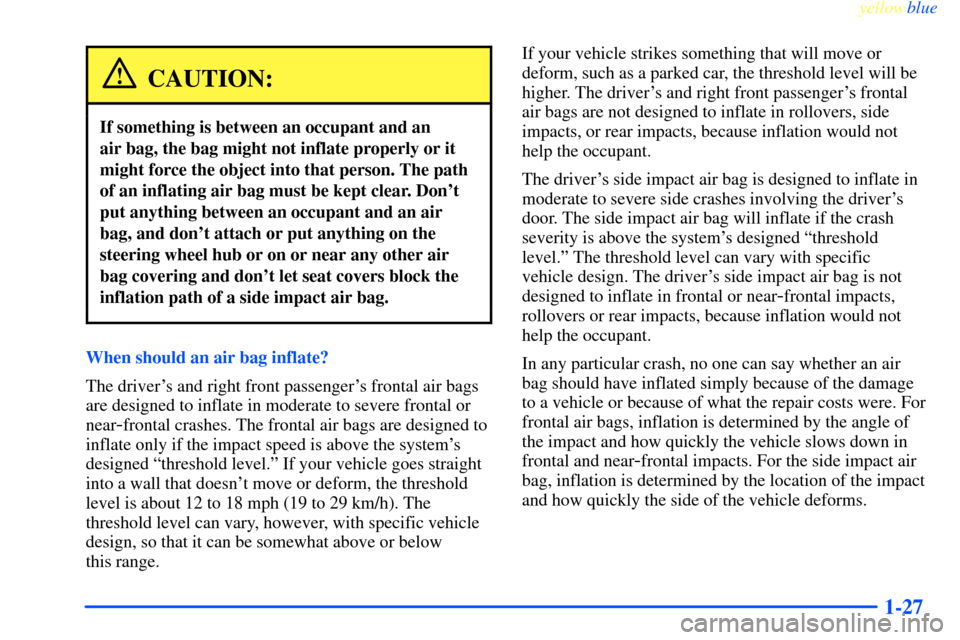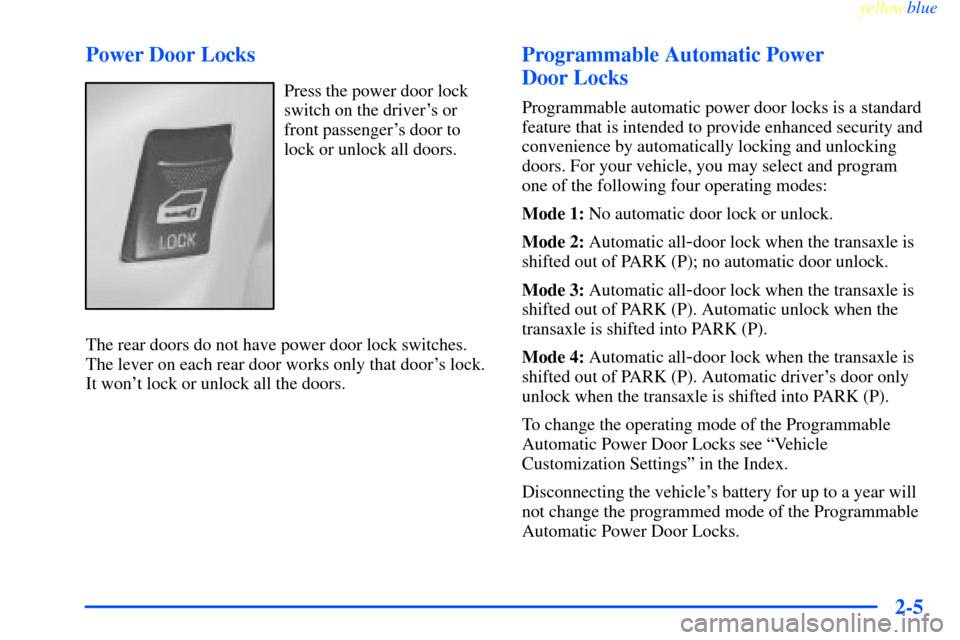Page 34 of 365

yellowblue
1-27
CAUTION:
If something is between an occupant and an
air bag, the bag might not inflate properly or it
might force the object into that person. The path
of an inflating air bag must be kept clear. Don't
put anything between an occupant and an air
bag, and don't attach or put anything on the
steering wheel hub or on or near any other air
bag covering and don't let seat covers block the
inflation path of a side impact air bag.
When should an air bag inflate?
The driver's and right front passenger's frontal air bags
are designed to inflate in moderate to severe frontal or
near
-frontal crashes. The frontal air bags are designed to
inflate only if the impact speed is above the system's
designed ªthreshold level.º If your vehicle goes straight
into a wall that doesn't move or deform, the threshold
level is about 12 to 18 mph (19 to 29 km/h). The
threshold level can vary, however, with specific vehicle
design, so that it can be somewhat above or below
this range. If your vehicle strikes something that will move or
deform, such as a parked car, the threshold level will be
higher. The driver's and right front passenger's frontal
air bags are not designed to inflate in rollovers, side
impacts, or rear impacts, because inflation would not
help the occupant.
The driver's side impact air bag is designed to inflate in
moderate to severe side crashes involving the driver's
door. The side impact air bag will inflate if the crash
severity is above the system's designed ªthreshold
level.º The threshold level can vary with specific
vehicle design. The driver's side impact air bag is not
designed to inflate in frontal or near
-frontal impacts,
rollovers or rear impacts, because inflation would not
help the occupant.
In any particular crash, no one can say whether an air
bag should have inflated simply because of the damage
to a vehicle or because of what the repair costs were. For
frontal air bags, inflation is determined by the angle of
the impact and how quickly the vehicle slows down in
frontal and near
-frontal impacts. For the side impact air
bag, inflation is determined by the location of the impact
and how quickly the side of the vehicle deforms.
Page 39 of 365
yellowblue
1-32
Rear Seat Passengers
It's very important for rear seat passengers to buckle up!
Accident statistics show that unbelted people in the rear
seat are hurt more often in crashes than those who are
wearing safety belts.
Rear passengers who aren't safety belted can be thrown
out of the vehicle in a crash. And they can strike others
in the vehicle who are wearing safety belts.
Rear Seat Passenger Positions
Lap-Shoulder Belt
All three rear seating positions have lap
-shoulder belts.
Here's how to wear one properly.
1. Pick up the latch plate and pull the belt across you.
Don't let it get twisted.
The shoulder belt may lock if you pull the belt across
you very quickly. If this happens, let the belt go back
slightly to unlock it. Then pull the belt across you
more slowly.
2. Push the latch plate into the buckle until it clicks.
Page 41 of 365
yellowblue
1-34
The lap part of the belt should be worn low and snug on
the hips, just touching the thighs. In a crash, this applies
force to the strong pelvic bones. And you'd be less likely
to slide under the lap belt. If you slid under it, the belt
would apply force at your abdomen. This could cause
serious or even fatal injuries. The shoulder belt should go
over the shoulder and across the chest. These parts of the
body are best able to take belt restraining forces.
The safety belt locks if there's a sudden stop or a crash,
or if you pull the belt very quickly out of the retractor.
Page 64 of 365

2-
yellowblue
2-1
Section 2 Features and Controls
Here you can learn about the many standard and optional features on your vehicle, and information on starting,
shifting and braking. Also explained are the instrument panel and the warning systems that tell you if everything is
working properly
-- and what to do if you have a problem.
2
-2 Keys
2-4 Door Locks
2
-6 Remote Keyless Entry (Option)
2
-10 Trunk
2
-11 Theft
2
-12 Content Theft-Deterrent (If Equipped)
2
-14 Vehicle Customization Settings
2
-19 Passlock�
2-20 New Vehicle ªBreak-Inº
2
-20 Ignition Switch
2
-21 Starting Your Engine
2
-24 Engine Coolant Heater (If Equipped)
2
-25 Automatic Transaxle Operation
2
-30 Parking Brake
2
-31 Shifting Into PARK (P)
2
-34 Shifting Out of PARK (P)
2
-34 Parking Over Things That Burn
2
-35 Engine Exhaust
2
-35 Running Your Engine While You're Parked2
-36 Windows
2
-37 Tilt Wheel Adjustable Steering Column
2
-38 Turn Signal/Multifunction Lever
2
-44 Exterior Lamps
2
-46 Interior Lamps
2
-48 Mirrors
2
-52 Accessory Power Receptacle
2
-52 Auxiliary Power Connection (Power Drop)
2
-53 Cellular Phone Readiness Package (If Equipped)
2
-53 OnStar� System (Option)
2
-54 Power Sunroof (Option)
2
-55 Universal Transmitter (If Equipped)
2
-58 The Instrument Panel -- Your
Information System
2
-59 Instrument Panel Cluster
2
-62 Warning Lights, Gages and Indicators
2
-71 Message Center
2
-77 Driver Information Center (DIC) (Option)
Page 66 of 365
yellowblue
2-3
One key is for the
ignition, the doors and
all other locks.
If you ever do get locked out of your vehicle, call the
Chevrolet Roadside Assistance Center at
1
-800-CHEV-USA�. (In Canada call 1-800-268-6800).
NOTICE:
Your vehicle has a number of features that can
help prevent theft. But you can have a lot of
trouble getting into your vehicle if you ever lock
your keys inside. You may even have to damage
your vehicle to get in. So be sure you have
extra keys.
Page 67 of 365
yellowblue
2-4
Door Locks
CAUTION:
Unlocked doors can be dangerous.
Passengers -- especially children -- can easily
open the doors and fall out. When a door is
locked, the inside handle won't open it.
Outsiders can easily enter through an unlocked
door when you slow down or stop your vehicle.
This may not be so obvious: You increase the
chance of being thrown out of the vehicle in a
crash if the doors aren't locked. Wear safety belts
properly, lock your doors, and you will be far
better off whenever you drive your vehicle.
There are several ways to lock and unlock your vehicle.
From the outside, use your door key or remote keyless
entry transmitter, if equipped.
From the inside, to lock the door manually, push the
lever forward. To unlock, pull the lever rearward.
Page 68 of 365

yellowblue
2-5 Power Door Locks
Press the power door lock
switch on the driver's or
front passenger's door to
lock or unlock all doors.
The rear doors do not have power door lock switches.
The lever on each rear door works only that door's lock.
It won't lock or unlock all the doors.
Programmable Automatic Power
Door Locks
Programmable automatic power door locks is a standard
feature that is intended to provide enhanced security and
convenience by automatically locking and unlocking
doors. For your vehicle, you may select and program
one of the following four operating modes:
Mode 1: No automatic door lock or unlock.
Mode 2: Automatic all
-door lock when the transaxle is
shifted out of PARK (P); no automatic door unlock.
Mode 3: Automatic all
-door lock when the transaxle is
shifted out of PARK (P). Automatic unlock when the
transaxle is shifted into PARK (P).
Mode 4: Automatic all
-door lock when the transaxle is
shifted out of PARK (P). Automatic driver's door only
unlock when the transaxle is shifted into PARK (P).
To change the operating mode of the Programmable
Automatic Power Door Locks see ªVehicle
Customization Settingsº in the Index.
Disconnecting the vehicle's battery for up to a year will
not change the programmed mode of the Programmable
Automatic Power Door Locks.
Page 69 of 365

yellowblue
2-6 Rear-Door Security Locks
Your vehicle is equipped with rear-door security locks that
help prevent passengers from opening the rear doors of
your vehicle from the inside. To use one of these locks:
1. Open one of the rear doors.
2. On the inside of the rear door will be a lock. Insert
your key into this lock and turn it upward. This will
engage the safety lock. To disengage the feature, turn
the lock downward.
3. Close the door.
4. Do the same thing to the other rear door lock.
The rear doors of your vehicle cannot be opened from
the inside when this feature is in use. If you want to
open the rear door when the security lock is on, unlock
the door and then open the door from the outside.
Lockout Protection Feature
To protect you from locking your key in the vehicle, this
feature stops the power door locks from locking when
the keys are in the ignition and a door is open.
If a power lock switch is pressed when a door is open
and the key is in the ignition, all of the doors will lock
and then the driver's door will unlock.
Leaving Your Vehicle
If you are leaving the vehicle, take your keys, open your
door and set the locks from inside. Then get out and
close the door.
Remote Keyless Entry (Option)
If your vehicle has this feature, you can lock and unlock
your doors or unlock your trunk from about 3 feet (1 m)
up to 30 feet (9 m) away using the remote keyless entry
transmitter supplied with your vehicle.
Your remote keyless entry system operates on a
radio frequency subject to Federal Communications
Commission (FCC) Rules and with Industry Canada.
This device complies with Part 15 of the FCC Rules.
Operation is subject to the following two conditions:
(1) this device may not cause harmful interference,
and (2) this device must accept any interference
received, including interference that may cause
undesired operation.
This device complies with RSS
-210 of Industry Canada.
Operation is subject to the following two conditions:
(1) this device may not cause interference, and (2) this
device must accept any interference received, including
interference that may cause undesired operation of
the device.